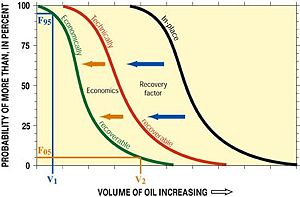
U.S. oil shale deposits are estimated to contain petroleum deposits potentially extractable by retorting with a mid-point volume estimate of 800 billion barrels (approximately three times the Saudi Arabian proven reserves). Some upper-bound estimates place this volume at over 2 trillion barrels (more than the current total worldwide proven reserves of about 1.2 trillion barrels – for another comparison, Canadian tar sands contain less than 200 billion barrels of estimated reserves).
 Image via Wikipedia
Image via Wikipedia
I believe that in situ retorting using freeze wall technology (although never attempted on a large scale) is a promising technology with a projected production (finding plus lifting) cost in the $30 per barrel range (this compares to about a little less than $10 per barrel for Saudi Arabian crude and about $20 per barrel for Wilmington (Long Beach) crude).
There are three major hurdles to shale oil production – initial infrastructure investment, environmental impacts, and the veracity of “proven reserve” estimates of conventional oil sources. The most problematic of these is the extent of environmental impacts.
![Reblog this post [with Zemanta]](http://img.zemanta.com/reblog_e.png?x-id=1d30148c-f8a2-4551-868d-e0582ec854da)